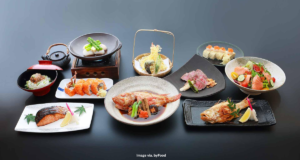Japanese cuisine is known for its fresh ingredients, delicate flavors and uncomparable preparation techniques then any other cuisine. The diversity of culinary experience of Japanese cuisine is known worldwide because it gives preference to taste buds of every type of people.Being Ramen to authentic Japanese food there are a wide range of food options when it comes to using Japanese food. So let’s dive on a journey to explore the top 10 must-try dishes from Japanese cuisine and have an experience full of delicacies. A Journey of Japanese Cuisine 1. Sushi: A Culinary Icon Sushi, the epitome of Japanese cuisine, holds an international value for its artistic presentation and perfect blend of exquisite taste. If you want to tantalize your taste buds then Sushi offers you a range of options to explore with. The best thing about Sushi is that this food item from Japanese cuisine is available in both vegetarian and non vegetarian avatars. You can select your Sushi roll as per your requirement ranging from professor to vegetarian dishes. Above all do not forget to dip your in the soy sauce, and if you want to get an authentic taste of Japanese culture do add a dab of wasabi on your tempting sushi. 2. Ramen: The Comfort Food We all are well aware of the most trending food world wide ‘Ramen’ . It is the thing that everyone is currently obsessed about. The fun fact about this Japanese food item is it is not just limited to a bowl of noodles rather it is a form of culinary journey that is comforting as well which will warm your souls. Chewy noodles, multiple toppings, and rich broth makes ramen a perfect comfort food to have anytime. Not just that ramen also comes in diverse style and distinct flavors. Whether you prefer tonkatsu, miso, or shoyu broth, a steaming bowl of ramen is sure to satisfy your cravings. 3. Tempura: Crispy Delights Widely popular for it’s crispy better and light texture Tempura is one of the most beloved Japanese dish, encasing an array of ingredients such as shrimp, vegetables, and seafood. The origin roots of this dish can be traced from Portuguese influence, now tempura has evolved into a staple of Japanese cuisine, that offers a delightful experience of flavors and contrast of various textures.To get a Savory punch do not forget Dip tempuras in tentsuyu sauce. 4. Matcha: Beyond Just Tea Finely ground green tea powder popularly known as Matcha has transcended its traditional role and become a versatile ingredient in Japanese cuisine. The best thing about Matcha is that it is not just a green tea powder but can be used in white range of desserts and copies which helps adding a vibrancy to the food items with green color powder and giving an authentic insight of Japan by making the dish full of antioxidants. Indulge in a matcha parfait or enjoy a traditional tea ceremony for a taste of Japanese culture or enjoy various desserts that are made from Matcha Powder. 5. Takoyaki: Quirky Street Food Takoyaki, bite-sized balls of grilled octopus batter, is a widely popular street food snack originated from Osaka. Takoyaki is that Japanese cuisine dish which is a perfect balance of crispy on the outside and creamy on the inside and served with mayonnaise and piping hot and the resulting tangy sauce on it.Experience the joy of watching these savory orbs cook on a hot griddle at bustling street stalls. It is truly and incredible experience you can have on your food tour. 6. Okonomiyaki: The Japanese Pancake The pancake might ignites your thoughts of having something sweet but Okonomiyaki, often referred to as a Japanese pancake or savory pancake, is a combination of cabbage with various toppings like pork belly, seafood, and bonito flakes which is totally customisable as per your taste preferences. Cooked on a griddle and slathered with savory okonomiyaki sauce and mayonnaise, this hearty dish is a favorite among locals and visitors alike. 7. Wagyu Beef: A True Delicacy Wagyu beef, prized for its unparalleled marbling and melt-in-your-mouth texture, is a luxurious indulgence that epitomizes Japanese culinary excellence. When it comes to consuming this delicacy there are abandoned of options to go with you can have it in a hot pot, as a Sushi or even as a steak.Wagyu beef has a flavored like no other and is a truly different experience.Treat yourself to this premium delicacy from Japanese cuisine for a truly unforgettable dining experience. 8. Mochi: Sweet and Chewy Treats Mochi, soft and chewy rice cakes, are a beloved Japanese confection enjoyed during special occasions and festivals. The special thing about this dish is that its taste is as mesmerizing as its appearance. It is available in diverse range of flavors from traditional and modern blend of delicacies like strawberry and green tea, mochi delights the senses with its delightful texture and subtle sweetness. You can enjoy Mochi as a snack or as a topping for shaved ice desserts whatever you find the best for you. 9. Onigiri: Portable Rice Balls Onigiri, is basically triangular shaped rice balls that are wrapped with the sea weeds and has a filling of savory ingredients inside of it. It is also a part of Japanese staple convenient cuisine. Whether stuffed with salmon, pickled plum, or grilled tuna, onigiri makes for a satisfying snack or light meal on the go. Experience the convenience and versatility of onigiri during your journey of exploring Japanese cuisine and its culinary adventures. 10. Sake: Japanese Rice Wine As we come to an end of our list of 10 most popular Japanese cuisine dishes. Now here’s the most iconic rice wine popular in Japan which holds a great cultural value in the entire Japanese cuisine. Sake is one of the most beloved drink of all the people of Japan and worldwide as well. With its nuanced flavors and smooth finish, sake complements a wide range of dishes, from sushi to grilled meats. No matter if you want to







